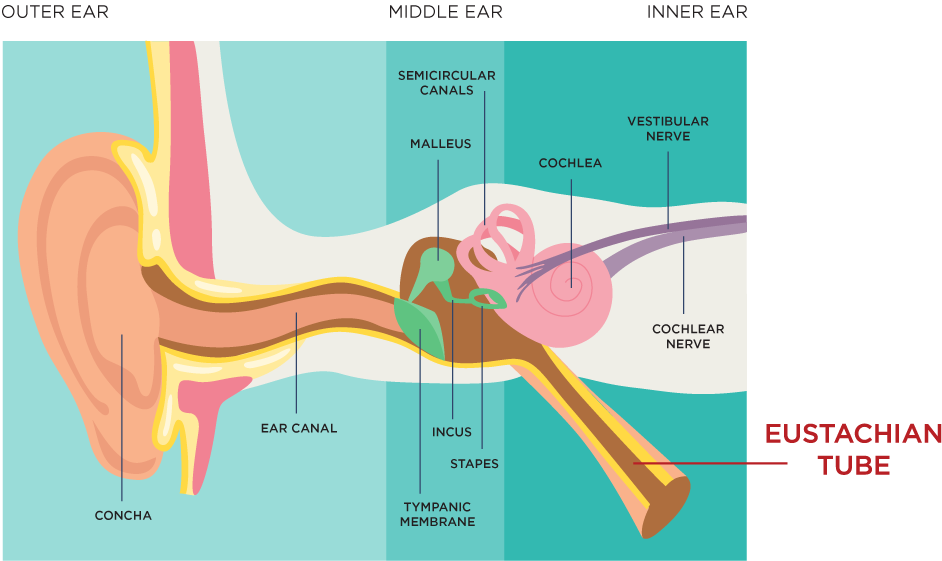If you’ve ever felt your ears plug up when taking off in an airplane, driving in the mountains, or even going up in an elevator, you have your eustachian tubes to thank.
What are eustachian tubes?
The eustachian tubes are tiny passageways that connect the middle ear to the back of the throat near the nose. By opening and closing throughout the day, these tubes are responsible for:
- Equalizing air pressure on either side of the eardrum
- Draining excess fluids or secretions
- Protecting the middle ear from bacteria that can cause infection and diseases
To illustrate, when the air pressure in a plane changes quickly, the eustachian tubes can’t react fast enough to balance the air pressure, leaving your hearing muffled hearing or your ears feeling full.
Swallowing or yawning can usually cause eustachian tubes to open up–or pop–and allow the middle ear to get more air, equalizing the air pressure. Look around, and fellow travelers may be drinking water or chewing gum at liftoff.

What is eustachian tube dysfunction (ETD)?
For many, eustachian tubes can cause more than temporary inconvenience or discomfort from flying. Individuals with eustachian tube dysfunction (ETD) have chronically inflamed or blocked eustachian tubes. This blockage can lead to a backup of fluids and several bothersome symptoms, including:
- Dull or muffled hearing
- Ear pain
- A feeling of fullness in the ear
- Tinnitus (ringing or buzzing in the ear)
- Dizziness
Left untreated, persistent eustachian tube dysfunction can damage the middle ear and the eardrum and, in severe cases, lead to hearing loss.
How are blocked eustachian tubes treated?
Blocked eustachian tubes can be relieved by nasal sprays and antihistamine tablets, which reduce inflammation and congestion. If your symptoms last longer than two weeks, see an ENT specialist.
Recurrent eustachian tube dysfunction requires additional intervention. In the past, individuals with ETD were commonly treated repeatedly with ear tubes. This involves surgically placing tiny plastic tubes through the eardrum to replace the function of the eustachian tube. Over time, these tubes tend to fall out and contribute to other complications, including eardrum perforation.
What is eustachian tube balloon dilation?
In recent years, the FDA has approved a minimally invasive surgical technique that uses a balloon to dilate or open this eustachian tube, giving patients longer, more effective relief.
The in-office procedure, performed under local anesthesia, uses a catheter to insert a small balloon through the nose and into the eustachian tube. The balloon is gently inflated to open up the passageway and restore normal function. Once the tube has been dilated, the balloon is deflated and removed. The procedure is painless, with no incisions or removal of bone required. From beginning to end, the process takes about 20 minutes.
What is the recovery time?
Recovery time is minimal, with many patients returning to normal activities within 24 hours with very mild side effects.
Learn more
Eustachian tube dysfunction does not have to impact your quality of life. We’ve seen countless patients benefit from the long-lasting relief from eustachian tube balloon dilation. Contact Oakdale ENT today by calling 763-233-5755 if you’re ready to learn more or schedule an appointment online.
